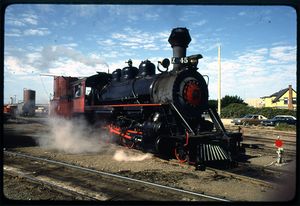California Western Railroad
| California Western Railroad | |
|---|---|
| logo | |
| System map Map of the California Western Railroad (created using nationalatlas.gov) | |
| Reporting marks | CWR |
| Locale | Fort Bragg - Willits, California |
| Dates of operation | 1885 as Fort Bragg Railroad – 2003 - sold to Sierra Railroad |
| Track gauge | 4 ft 8½ in (1435 mm) (standard gauge) |
| Headquarters | Fort Bragg, California |
The California Western Railroad (AAR reporting marks CWR), popularly called the Skunk Train, is a heritage railway in California.
The CWR runs steam and diesel-powered trains and rail motor cars 40 miles through redwood forests along Pudding Creek and the Noyo River. Along the way, the tracks cross some 30 bridges and trestles and pass through two deep mountain tunnels. The half-way point of Northspur is a popular meals and beverage spot for the railroad's passengers when locomotives turn around before returning trains to their respective terminals.
History
The railroad was originally built by the Fort Bragg Redwood Company as the Fort Bragg Railroad in 1885 to carry coast redwood logs from the dense forests at Glenela (Glen Blair) to a newly built lumber mill located 6.6 miles to the west at coastal Fort Bragg, California. Fort Bragg Redwood Company was incorporated into the new Union Lumber Company in 1904; the railroad ownership always rested with the parent lumber company until 1969. On July 1 1905 the railroad was renamed the California Western Railroad & Navigation Company. In 1904 passenger service was added, and on December 11 1911 the route was completed to its total length of 40 miles roughly following the Noyo River, ending in the inland town of Willits, California.
On December 19 1947 the railroad name was shortened to the California Western Railroad. Union Lumber and its California Western Railroad came under the ownership of the various lumber producers, including Boise Cascade (1969), and later Georgia-Pacific Corporation; G-P initially leased the CWR's operations to Kyle Railways, but in June 1987 the CWR was sold to the Kyle Railways subsidiary Mendocino Coast Railway. Mendocino Coast Railway continued to operate the CWR under the California Western name. No longer able to make a profit when the G-P mill began to reduce operations and finally closed altogether, Kyle Railways opted to sell the financially starved CWR. On December 17 2003 the California Western Railroad was rescued when it was bought by the Sierra Railroad. The Sierra Railroad's Sierra Entertainment Group now operates the Skunk Train in addition to its Sacramento RiverTrain in Woodland, California and the Sierra Railroad line between Oakdale and Keystone, California. The Sierra Railroad diminished the California Western Railroad name in favor of the Skunk Train [tm] when it took over the CWR line.
Freight traffic
After the latter 1980s the railroad's freight redwood lumber traffic rapidly declined. Georgia-Pacific gradually shifted lumber shipments to more flexible highway trucks until the Northwestern Pacific Railroad [North Coast Railroad Authority] was embargoed and shut-down from Willits to the California Northern Railroad and Union Pacific mainline connection near the SF Bay Area. By 1996, before the NWP embargo, CWR lumber shipments were less than 500 cars per year and passenger service became the line's main source of revenue. Today the passenger excursion trains are the railroad's sole source of revenue.
Skunk Train
Gas-powered, self propelled and very economical passenger motorcars were added in 1925 and CWR steam passenger trains were mostly eliminated. These motorcars were nicknamed "Skunks" because people said "You can smell 'em before you can see 'em." In 1965 the line reintroduced summer steam passenger service between Fort Bragg and Willits with Baldwin-built steam locomotive No.45, calling the colorful train "The Super Skunk." No.45 continues to power excursion trains from Fort Bragg as far as Northspur, the CWR's mid-point, on selected weekends summer to early autumn.
Without the considerable revenue lumber and general merchandise freight once contributed to the bottom line, maintaining the railway through such rugged terrain is a major undertaking, both logistically and financially, and service is not always available for the full trip from Fort Bragg to Willits. However, shorter trips to intermediate points usually run year-round.
The railroad has also been featured in several movies, including The Signal Tower (Universal Studios - 1924), Racing with the Moon and The Majestic.
References
- CWR & Union Lumber corporate records and ULCo/CWR history book manuscript being prepared by K.V. Bunker, 2006.
- Squires, Wendy. "Sierra Railroad buys historic Skunk Train", Press Release, Sierra Railroad, December 19 2003, pp. 2. Retrieved on 2006-04-22.

